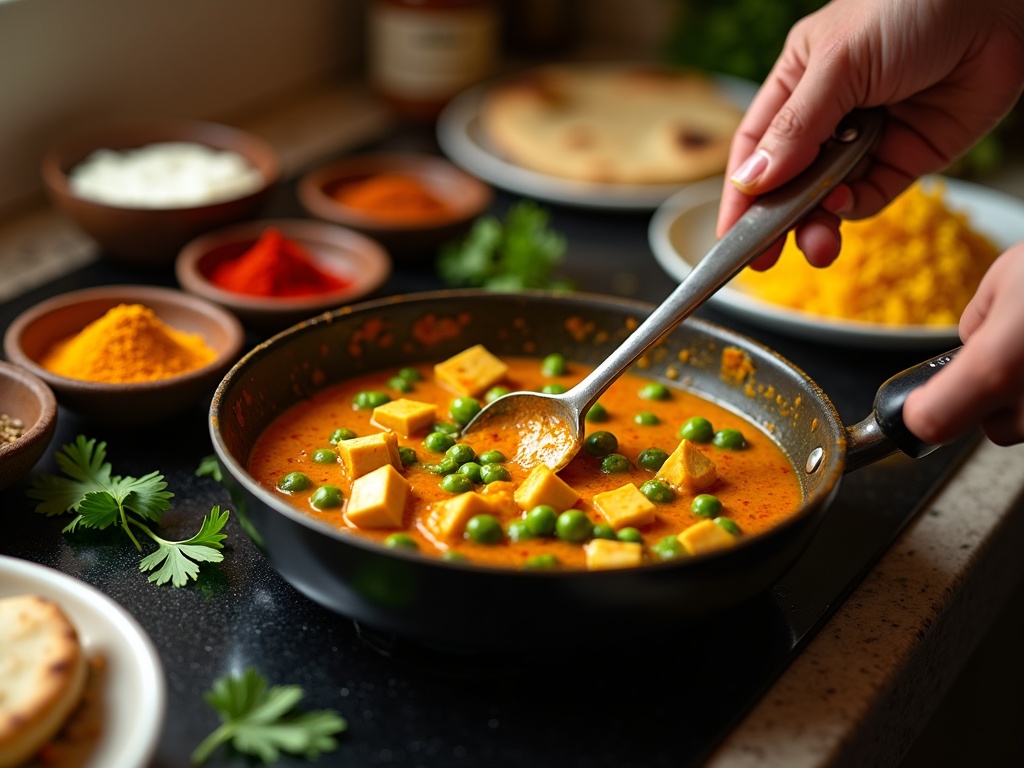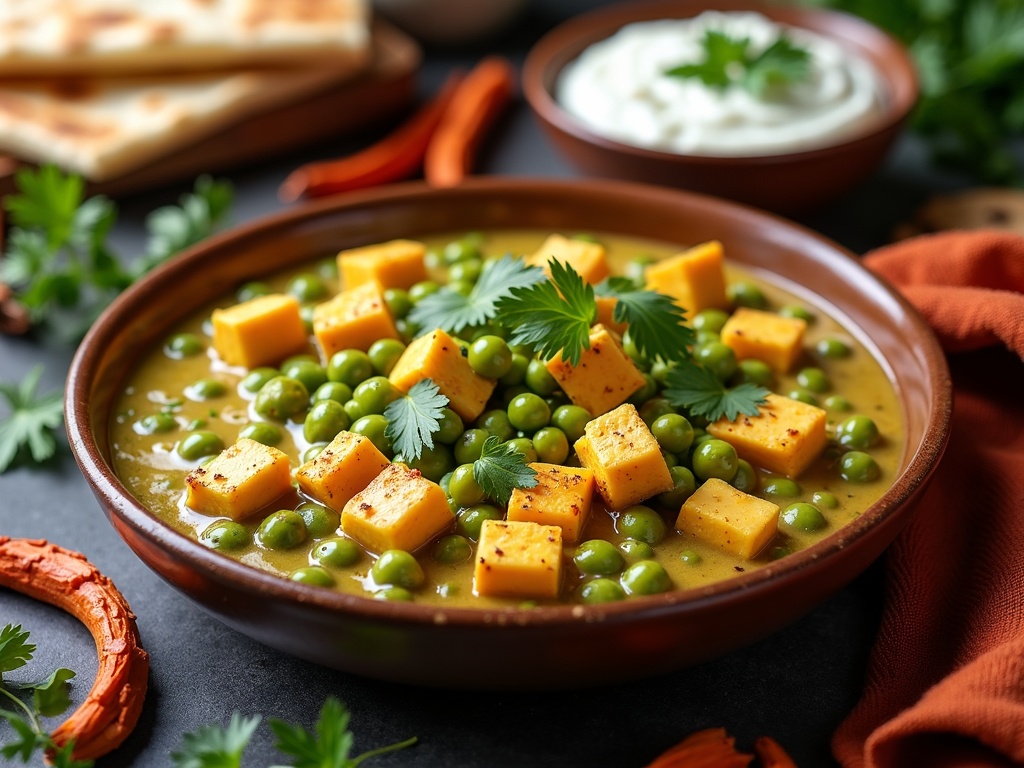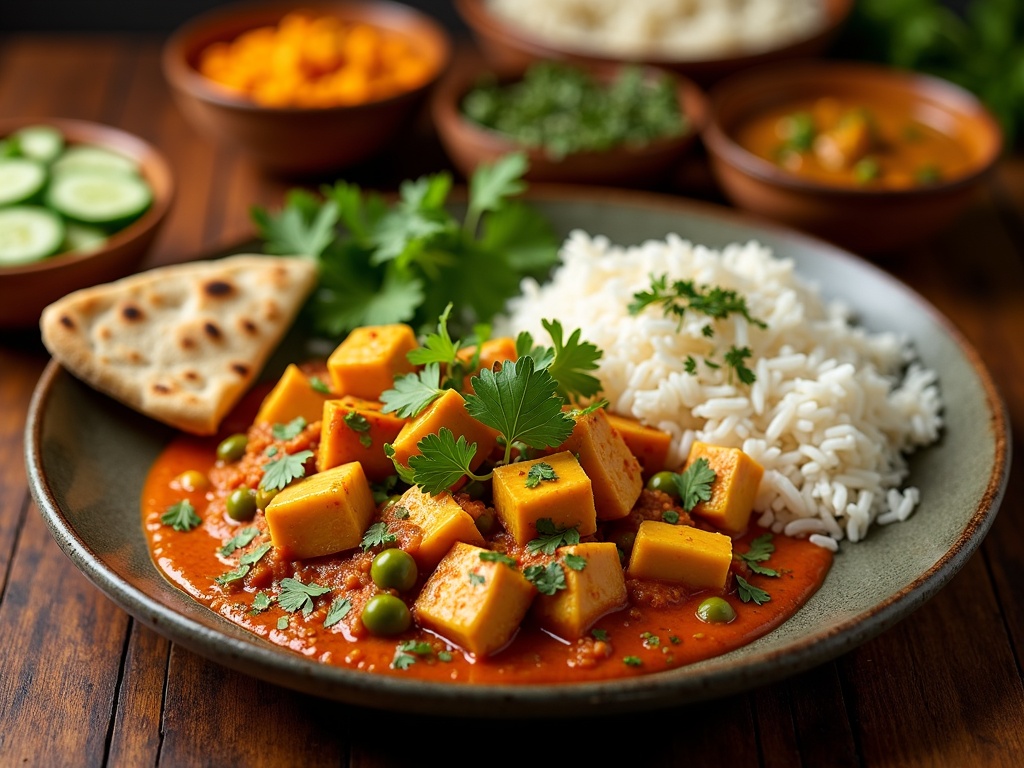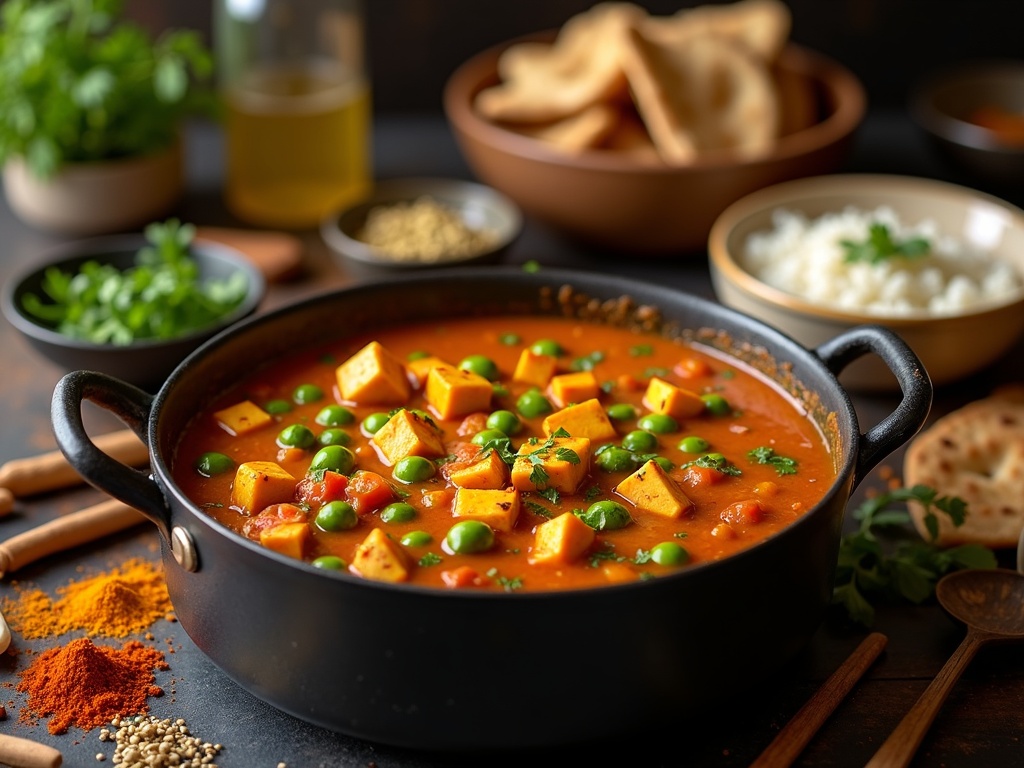Matar paneer recipe is a beloved North Indian curry that combines creamy paneer cubes with sweet green peas in a rich, spiced tomato-based gravy that balances deep flavors with comforting textures. The dish gets its distinctive character through a thoughtful blend of aromatic spices like cumin, coriander, turmeric, and garam masala, creating a restaurant-quality experience that I can easily prepare at home in under 40 minutes.
Find In This Article
Key Takeaways
- The recipe requires about 200g of paneer, 1 cup of green peas, and a balanced spice blend including cumin seeds, garam masala, turmeric, and coriander powder.
- Matar paneer delivers approximately 12-15g of protein per serving, making it an excellent option for vegetarians seeking nutritious meal options.
- The cooking process involves creating a flavorful base gravy first, then adding peas, and finally incorporating paneer during the last few minutes to maintain its soft texture.
- Creative variations include adding cream for a richer “butter masala” version, incorporating cashew paste for velvety texture, or blending in spinach for added nutrients.
- The dish pairs perfectly with basmati rice, naan bread, or paratha, and can be served alongside complementary dishes like dal makhani or raita for a complete meal.
The Perfect Blend of Spices and Ingredients
I’ve discovered that the magic of matar paneer lies in its perfectly balanced blend of spices and fresh ingredients. This delicious North Indian curry combines creamy paneer cubes with sweet green peas in a rich tomato-based gravy that’s bursting with flavor. Let me share exactly what you’ll need to create this beloved dish at home.
Essential Ingredients List
For the perfect matar paneer that serves 2-4 people, you’ll need these precise measurements:
- 200g paneer, cut into 1-inch cubes
- 1 cup fresh or frozen green peas
- 2 medium onions, finely chopped
- 2 medium tomatoes, pureed
- 2 tablespoons vegetable oil or ghee
- 1 teaspoon cumin seeds
- 1 teaspoon garam masala
- ½ teaspoon turmeric powder
- 1 tablespoon coriander powder
- 1 teaspoon red chili powder (adjust to taste)
- 2 cloves garlic, minced
- 1-inch ginger piece, grated
- 2 green chilies, slit (optional)
- ¼ cup fresh cream
- Salt to taste
- Fresh coriander leaves for garnishing
- ½ cup water (adjust for desired consistency)
The star ingredients—paneer and green peas—create the foundation of this dish. The soft, milky paneer cubes absorb the spice flavors beautifully while the sweet peas provide a delightful textural contrast. If you enjoy working with paneer, you might also love trying royal shahi paneer for a more decadent experience.
Spice Blend Secrets
The spice blend is what transforms simple ingredients into an aromatic masterpiece. The 1 teaspoon of cumin seeds forms the base flavor when tempered in hot oil, releasing their nutty aroma. The ½ teaspoon of turmeric adds not only a golden hue but also earthy warmth and health benefits.
The tablespoon of coriander powder brings a citrusy note that balances the richness, while the finishing touch of 1 teaspoon garam masala ties everything together with its complex spice profile. Each spice plays a crucial role in building layers of flavor.
I’ve found that freshly ground spices make a noticeable difference. If possible, toast whole spices and grind them just before cooking for the most vibrant flavor. For those who enjoy the creamy richness of North Indian curries, a traditional butter chicken uses a similar spice profile.
The beauty of matar paneer lies in its balance—it’s rich without being heavy, flavorful without overwhelming heat. At just 200-250 calories per serving, it’s also relatively light for such a satisfying dish. The cream adds a luxurious finish but can be reduced or substituted with yogurt for a lighter version.
For a complete meal, I pair this with naan bread or steamed rice. The gravy is perfect for scooping up with roti or mixing into rice. If you’re planning a full Indian feast, consider adding creamy dal makhani for a protein-rich complement.
When preparing the paneer, you can either add it directly to the gravy or lightly pan-fry it first for a slightly crispy exterior. The peas can be fresh or frozen—both work wonderfully, though fresh peas bring a delightful sweetness when in season.
For additional vegetarian options to serve alongside your matar paneer, a flavorful mixed vegetable curry offers a wonderful contrast of textures and tastes. Or for another paneer variation, try spiced paneer masala which uses a different spice profile.
With these carefully measured ingredients and spice combinations, you’re set to create an authentic matar paneer that brings the flavors of Indian cuisine right to your kitchen.
Step-by-Step Cooking Method
Preparing matar paneer might seem like a challenge, but with this straightforward approach, I’ll guide you through creating a restaurant-quality dish in your own kitchen. The entire process takes about 30-40 minutes, making it perfect for weeknight dinners when you want something special without spending hours at the stove.
Preparing the Base Gravy
I start by heating 2 tablespoons of oil or ghee in a heavy-bottomed pan over medium heat. Once hot, I add cumin seeds and let them crackle for about 30 seconds. This releases their aromatic oils and creates a solid foundation for the dish.
Next comes the ginger-garlic paste – about 1 tablespoon – which needs exactly 2-3 minutes of cooking time. This step is crucial as it removes the raw smell while preserving the flavors. If you rush this step, the paste might remain raw; cook it too long, and it could burn and turn bitter.
After the ginger-garlic paste is golden, I add finely chopped onions and sauté until translucent, usually 3-4 minutes. Then comes the spice blend – typically turmeric, red chili powder, coriander powder, and garam masala. I stir continuously for about a minute to prevent the spices from burning.
The tomato puree goes in next, requiring 5-7 minutes of cooking time. Here’s where patience pays off – I cook until the oil starts separating from the mixture and the raw tomato smell disappears. This indicates the base gravy has developed proper flavor depth.
For additional creaminess in the gravy, similar to what you’d find in authentic butter chicken, I add 2-3 tablespoons of cream or cashew paste at this stage.
Incorporating Paneer and Peas
Once my base gravy reaches the right consistency, I add about 1 cup of water, adjusting for my preferred gravy thickness. After bringing it to a gentle simmer, I add the green peas. Fresh peas need about 5-7 minutes to cook through, while frozen ones require just 3-4 minutes.
Here are some key points for achieving the perfect gravy consistency:
- Start with less water and add more if needed
- Allow the gravy to simmer uncovered if it’s too thin
- For thicker gravy, mix 1 teaspoon of cornstarch with water and stir in
- Balance the gravy thickness with the amount of paneer and peas
The paneer goes in last, as overcooking makes it tough and rubbery. I add the paneer cubes, giving them just 3-5 minutes to absorb the flavors without losing their softness. This timing is especially important if you’re using homemade paneer, which is more delicate than store-bought versions.
For extra softness, I sometimes soak the paneer cubes in warm water for 10 minutes before adding them to the gravy. This technique works wonders for shahi paneer as well, ensuring the cheese remains tender throughout.
If you’re using frozen paneer, let it thaw completely at room temperature before adding it to your vegetable curry. This prevents temperature shock that can toughen the cheese.
After adding the paneer, I finish with a final adjustment of salt and a sprinkle of garam masala for an aromatic punch. Then I turn off the heat and let the dish sit covered for 5 minutes, allowing the flavors to meld together beautifully.
For the final touch, I garnish with freshly chopped coriander leaves, which adds a burst of color and freshness. A drizzle of cream or a pat of butter can also enhance the visual appeal and taste, similar to finishing touches you might add to dal makhani or other rich curries.
For a complete North Indian meal experience, serve your matar paneer hot with naan, roti, or jeera rice. The combination of creamy gravy, tender paneer, and sweet peas creates a balanced dish that pairs wonderfully with other classics like paneer masala in a festive spread.

Nutritional Benefits and Health Value
Matar paneer isn’t just a delicious dish—it’s packed with nutrients that can fuel your body. This protein-rich vegetarian curry combines the goodness of cottage cheese (paneer) and green peas (matar) to create a balanced meal that satisfies both your taste buds and nutritional needs.
Protein Powerhouse with Balanced Nutrients
Paneer forms the backbone of this dish’s nutritional profile. With approximately 25g of protein, 20g of fat, and just 1.2g of carbohydrates per 100g, paneer provides substantial protein without loading you up with carbs. I’ve found that using homemade paneer can enhance both the flavor and nutritional value, though store-bought works well too for a quick paneer recipe at home.
Green peas complement paneer perfectly by adding their own nutritional punch. A single cup of green peas contains about 67 calories, 5g of protein, and 12g of carbohydrates. These little green gems are also fiber-rich, which helps with digestion and keeps you feeling full longer.
When combined in a serving of matar paneer, you’re looking at approximately 12-15g of protein per serving. This makes the dish particularly valuable for vegetarians who might struggle to meet their daily protein requirements. If you’re following a vegetarian diet, rotating between paneer masala and matar paneer can help maintain variety while ensuring adequate protein intake.
Beyond protein, matar paneer offers several other health benefits:
- Essential vitamins from peas, including vitamins A, C, and K
- Calcium and phosphorus from paneer for bone health
- Antioxidants that help fight inflammation
- Iron content that supports healthy blood cells
- Dietary fiber that aids digestion
The tomato-based gravy adds additional nutrients, including lycopene, a powerful antioxidant. You can adjust the fat content by controlling how much cream or butter goes into your recipe. For a lighter version, I sometimes substitute full-fat cream with yogurt or reduce the amount of oil used for tempering spices.
While matar paneer is nutritious on its own, pairing it with brown rice or whole wheat roti boosts the fiber content of your meal. For a complete North Indian feast, consider serving it alongside dal makhani or butter chicken for guests who eat meat.
Compared to many other curry dishes like vegetable curry, matar paneer has a higher protein-to-carb ratio, making it suitable for those watching their carbohydrate intake while still wanting something satisfying and flavorful.
The beauty of matar paneer lies in its balance—it provides protein, healthy fats, and moderate carbs in one delicious package. It’s filling enough to stand alone as a main course but versatile enough to serve as part of a larger meal. Whether you’re cooking for nutritional purposes or simply because you love Indian cuisine, matar paneer delivers on both fronts.
Creative Variations to Try
I’ve experimented with numerous matar paneer adaptations over the years and discovered some delicious twists that breathe fresh life into this classic dish. These variations maintain the authentic core while adding exciting new dimensions to please different palates.
Luxurious Creamy Adaptations
For special occasions, I love preparing Matar Paneer Butter Masala – a richer version of the traditional recipe. I simply add 3-4 tablespoons of heavy cream during the final few minutes of cooking, creating a silky, indulgent gravy that pairs beautifully with naan. This adaptation shares DNA with the beloved butter chicken dish but maintains its vegetarian integrity.
Another game-changing modification involves substituting tomato paste with cashew paste. I soak about 15-20 cashews in hot water for 30 minutes, then blend them into a smooth paste. This creates an incredibly velvety texture while adding subtle nutty undertones that complement the paneer perfectly. For an even more luxurious result, I sometimes combine this with the cream variation above – perfect for impressing dinner guests!
Flavor-Forward Alternatives
When I crave extra heat, I incorporate 2-3 additional green chilies or a teaspoon of red chili flakes to the base gravy. This spicy version pairs exceptionally well with cooling raita and plain rice to balance the heat. It’s reminiscent of a fiery paneer masala but with the added sweetness of peas.
For a nutritional boost, I occasionally blend blanched spinach into the tomato base, creating a hybrid between matar paneer and palak paneer. This verdant variation adds vibrant color, earthy flavor, and extra nutrients to the dish. The spinach naturally thickens the gravy, reducing the need for cream while still maintaining a luscious mouthfeel similar to dal makhani.
These variations can be customized further based on dietary needs:
- Swap ghee with oil for a dairy-reduced version
- Use tofu instead of traditional paneer for a vegan adaptation
- Add mixed vegetables like carrots and bell peppers for a heartier vegetable curry experience
- Reduce cream and use yogurt for a lighter finish
Each adaptation maintains the soul of matar paneer while offering fresh experiences for both everyday meals and special occasions.

Serving Suggestions and Pairings
Matar paneer pairs beautifully with several traditional Indian accompaniments that help balance its rich flavors and creamy texture. I’ve found that fluffy basmati rice makes an excellent base, soaking up the delicious gravy while providing a subtle contrast to the spiced dish. For a more indulgent meal, fresh naan bread or flaky paratha serve as perfect scooping tools to enjoy every bit of the flavorful sauce.
Customizing Your Matar Paneer Experience
When serving matar paneer, I like to adjust the consistency based on how I plan to enjoy it. For rice pairings, a slightly thinner gravy works wonderfully as it coats each grain perfectly. When serving with bread like naan or roti, I prefer a thicker consistency that stays on the bread without dripping. Simply add a little water to thin the gravy or simmer it longer to thicken as needed.
Spice levels can easily be customized to suit different palates:
- For milder flavor, reduce the amount of green chilies and garam masala
- For medium heat, follow the standard recipe proportions
- For spice lovers, add an extra green chili or a pinch of red chili powder
The visual presentation elevates the dining experience significantly. I garnish my matar paneer with fresh cilantro, a swirl of cream, or a few kasuri methi leaves for an authentic restaurant-style finish. For special occasions, a light sprinkle of garam masala or a few thin slices of ginger can add both visual appeal and flavor depth.
When planning portion sizes, I typically allow 1/2 cup of matar paneer per person as a side dish, or 1 cup per person when serving it as a main course. This dish pairs wonderfully with other North Indian favorites like dal makhani or butter chicken for a complete meal.
For a lighter meal, serve matar paneer alongside a refreshing cucumber raita or a simple green salad. If you enjoy experimenting with paneer dishes, you might also appreciate shahi paneer or paneer masala for variety in your menu planning. A colorful vegetable curry also makes a fantastic addition to round out the meal with extra nutrients and textures.

Sources:
Paneer Recipes: A Comprehensive Guide, Indian Cooking Archives
The Benefits of Green Peas, Nutrition Today
Recipe Variations: Matar Paneer, Food for Thought

